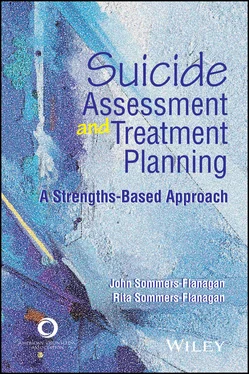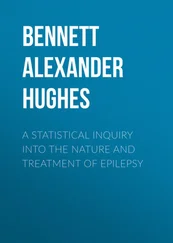John Sommers-Flanagan - Suicide Assessment and Treatment Planning
Здесь есть возможность читать онлайн «John Sommers-Flanagan - Suicide Assessment and Treatment Planning» — ознакомительный отрывок электронной книги совершенно бесплатно, а после прочтения отрывка купить полную версию. В некоторых случаях можно слушать аудио, скачать через торрент в формате fb2 и присутствует краткое содержание. Жанр: unrecognised, на английском языке. Описание произведения, (предисловие) а так же отзывы посетителей доступны на портале библиотеки ЛибКат.
- Название:Suicide Assessment and Treatment Planning
- Автор:
- Жанр:
- Год:неизвестен
- ISBN:нет данных
- Рейтинг книги:4 / 5. Голосов: 1
-
Избранное:Добавить в избранное
- Отзывы:
-
Ваша оценка:
- 80
- 1
- 2
- 3
- 4
- 5
Suicide Assessment and Treatment Planning: краткое содержание, описание и аннотация
Предлагаем к чтению аннотацию, описание, краткое содержание или предисловие (зависит от того, что написал сам автор книги «Suicide Assessment and Treatment Planning»). Если вы не нашли необходимую информацию о книге — напишите в комментариях, мы постараемся отыскать её.
Suicide Assessment and Treatment Planning — читать онлайн ознакомительный отрывок
Ниже представлен текст книги, разбитый по страницам. Система сохранения места последней прочитанной страницы, позволяет с удобством читать онлайн бесплатно книгу «Suicide Assessment and Treatment Planning», без необходимости каждый раз заново искать на чём Вы остановились. Поставьте закладку, и сможете в любой момент перейти на страницу, на которой закончили чтение.
Интервал:
Закладка:
Seven Dimensions of Being Human: Where Does It Hurt, and How Can I Help You?
We began this chapter by describing the case of Alina. Most likely, what you remember about Alina is that she is displaying several frightening suicide risk factors and has openly shared her suicidal thoughts. However, Alina is not just a person who is suicidal—she is a unique individual with a delightful array of idiosyncratic quirks, problems, and strengths who also happens to have suicidal thoughts.
When clients or students begin talking about suicide, it is easy to overly focus on suicidality. Suicidality is such a huge issue that it overshadows nearly everything else and consumes your attention. Nevertheless, all clients—suicidal or not—are richly complex and have a fascinating mix of strengths and weaknesses that deserve attention. To help keep focused on the whole person—and not just on weaknesses or pathology—we use a seven-dimension model for understanding people with suicidal thoughts and impulses.
Suicide Treatment Models
In the book Brief Cognitive-Behavioral Therapy for Suicide Prevention , Bryan and Rudd (2018) described and assessed three distinct suicide intervention models. The risk factor model emphasizes correlates and predictors of suicidal ideation and behavior. Practitioners who follow the risk factor model aim their treatments toward reducing known risk factors and increasing protective factors. Unfortunately, a dizzying array of risk factors exist; some are relatively unchangeable; and in a large, 50-year, meta-analytic study, researchers concluded that risk factors, protective factors, and warning signs are largely inaccurate and not useful (Franklin et al., 2017). Consequently, treatments based on the risk factor model are not in favor.
The psychiatric model focuses on treating psychiatric illnesses to reduce or prevent suicidality. The presumption is that clients experiencing suicidality should be treated for the symptoms linked to their diagnosis. Clients with depression should be treated for depression, clients diagnosed with posttraumatic stress disorder should be treated for trauma, and so on. Bryan and Rudd (2018) noted that “accumulating evidence has failed to support the effectiveness of this conceptual framework” (p. 4).
The final model is the functional model . Bryan and Rudd (2018) wrote, “According to this model, suicidal thoughts and behaviors are conceptualized as the outcome of underlying psychopathological processes that specifically precipitate and maintain suicidal thoughts and behaviors over time” (p. 4). The functional model targets suicidal thoughts and behaviors within the context of the individual’s history and present circumstances. Bryan and Rudd emphasized that the superiority of the functional model is “well established” (pp. 5–6; they cited a meta-analysis showing that functional approaches are significantly superior to the psychiatric model for suicide risk reduction; Tarrier et al., 2008).
Our approach differs from the functional model in several ways. Given our wellness and strengths-based orientation, we studiously avoid presuming that suicidality is a psychopathological process. Instead, consistent with social constructionist philosophy, we believe that locating psychopathological processes within clients risks exacerbating and perpetuating psychopathology as an internalized phenomenon (Hansen, 2015; Lyddon, 1995). From a constructionist perspective, client problems (including suicidality) are not necessarily within the self but instead are viewed as constructed by individuals and social groups. In addition to our wellness, strengths-based, constructionist foundation, we rely on an integration of robust suicide theory and practice (we rely on works from Jobes, Joiner, Klonsky & May, Linehan, O’Connor, and Shneidman). We also embrace parts of the functional model, especially the emphasis on individualized contextual factors that can increase or decrease risk. Overall, our goal is to provide counseling practitioners with a practical and strengths-based model for working effectively with clients and students who are suicidal.
The Seven Dimensions
Counseling and psychotherapy theorists and practitioners have a long history of using dimensional models to formulate client problems and develop treatment plans (Ellis, 1962; Lazarus, 2006; Myers, 1991; Witmer & Sweeney, 1992). Many authorities in many disciplines have articulated life dimensions. Some argue for three, others for five, seven, or nine dimensions. We settled on seven that we believe reflect common sense, science, philosophy, and convenience. Each dimension is multifaceted, overlapping, dynamic, and interactive. Each dimension includes at least three underlying factors that have theoretical and empirical support as drivers of suicidal ideation or behavior (J. Sommers-Flanagan, 2018a). The dimensions and their underlying factors are shown in Table 1.1.
In her memoir, Judy Collins (2003) wrote, “Two questions that are at the heart of treating someone who wishes to end their life are: ‘Where does it hurt?’ and ‘How can I help you?’” (p. 117). The “hurt” Collins refers to is not always located in a single place. Chronic pain, social isolation, lack of employment or shelter, emotional turmoil, constricted thinking, destructive habits, addictions, existential nihilism, and many more factors can trigger suicidality.
Given the immense range and complexity of human suffering and helping options, we believe that organizing our search for “where it hurts” and “how we can help” is essential. Using the seven-dimension model for case formulation will make it easier to notice and nurture client strengths. In addition to Collins’s questions of “Where does it hurt?” and “How can I help you?” we add “Where are you strong?”
TABLE 1.1Brief Descriptions of the Seven Dimensions
| Dimension | Evidence-Based Suicide Driver | Wellness Goal |
| Emotional | ||
| All human emotions Cognitive | 1. Excruciating emotional distress | 1. Emotional peace and calm |
| 2. Specific disturbing emotions (guilt, shame, anger, or sadness) | 2. Specific positive emotions (happiness, joy, etc.) | |
| 3. Emotional dysregulation | 3. Emotional regulation | |
| All forms of human thought, including imagery Interpersonal | 1. Hopelessness | 1. Hope |
| 2. Problem-solving impairments | 2. Problem-solving skills | |
| 3. Maladaptive thoughts | 3. Adaptive thoughts and beliefs | |
| 4. Negative core beliefs | 4. Positive core beliefs | |
| All human relationships | 1. Social disconnection and perceived burdensomeness | 1. Social connection and perceived usefulness |
| 2. Interpersonal loss and grief | 2. Skills for coping with loss | |
| 3. Social skill deficits | 3. Positive social skills | |
| 4. Repeating dysfunctional relationship patterns | 4. Repeating functional relationship patterns | |
| Physical | ||
| All human biogenetics and physiology | 1. Biogenetic predispositions and physical illness | 1. Healthy biogenetics and wellness |
| 2. Sedentary lifestyle, poor nutrition | 2. Active lifestyle, positive nutrition | |
| 3. Agitation, arousal, anxiety | 3. Physical calmness | |
| 4. Trauma, nightmares, insomnia | 4. Skills for coping with trauma | |
| Cultural-spiritual | ||
| All religious, spiritual, or cultural values that provide meaning and purpose | 1. Religious or spiritual disconnection | 1. Religious or spiritual connection |
| 2. Cultural disconnection or dislocation | 2. Cultural connection | |
| 3. Meaninglessness | 3. Meaningfulness | |
| Behavioral | ||
| All human action and activity Contextual | 1. Using substances or cutting for desensitization | 1. Openness to experience |
| 2. Suicide planning, intent, and preparation | 2. Life planning and preparation | |
| 3. Impulsivity | 3. Self-control | |
| All factors outside of the individual that influence human behavior | 1. No connection to place or nature | 1. Connection to place or nature |
| 2. Chronic exposure to unhealthy environmental conditions | 2. Healthy environmental conditions | |
| 3. Socioeconomic oppression or resource scarcity (e.g., poverty) | 3. Socioeconomic support, resources, and social justice |
Using the Seven-Dimension Model for Initial Treatment Planning
Интервал:
Закладка:
Похожие книги на «Suicide Assessment and Treatment Planning»
Представляем Вашему вниманию похожие книги на «Suicide Assessment and Treatment Planning» списком для выбора. Мы отобрали схожую по названию и смыслу литературу в надежде предоставить читателям больше вариантов отыскать новые, интересные, ещё непрочитанные произведения.
Обсуждение, отзывы о книге «Suicide Assessment and Treatment Planning» и просто собственные мнения читателей. Оставьте ваши комментарии, напишите, что Вы думаете о произведении, его смысле или главных героях. Укажите что конкретно понравилось, а что нет, и почему Вы так считаете.











